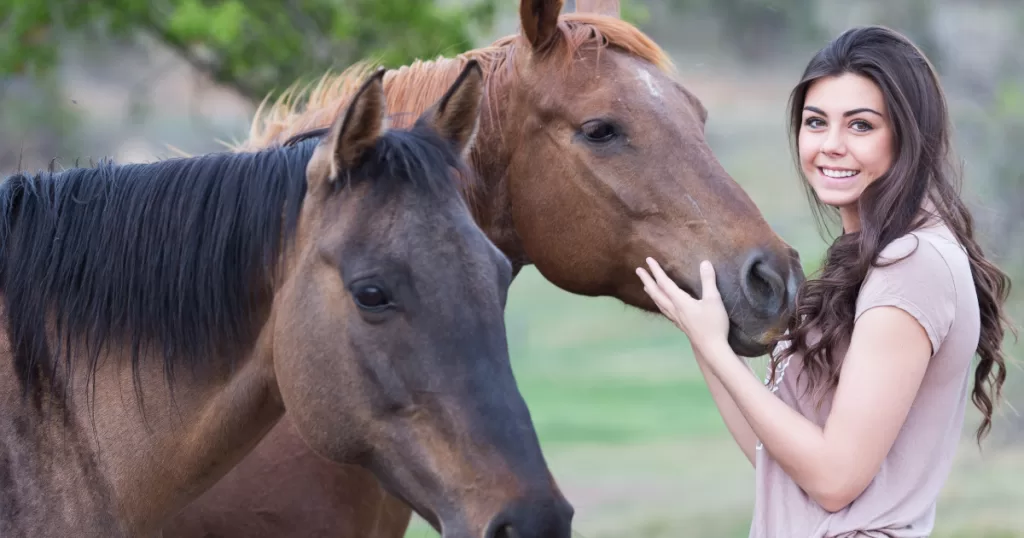
Horses are magnificent creatures with complex behaviors that can sometimes seem puzzling to those new to the equestrian world. Understanding your horse’s behavior is key to building a strong bond, ensuring their well-being, and improving your riding experience. This guide will help you decode some common horse behaviors, so you can better communicate with your equine companion.
Ready to Become a Confident Rider?
Sign up to our Free Newsletter for exclusive tips, tricks and tidbits that will help you grow as a beginner equestrian.
The Importance of Body Language
Horses are highly communicative animals, using body language as their primary form of interaction. Understanding the subtleties of your horse’s body language can help you gauge their mood, intentions, and health.
- Ears: A horse’s ears are a great indicator of its mood. Ears forward typically mean they are interested and attentive. Ears pinned back could signify irritation, discomfort, or aggression. If the ears are flicking back and forth, your horse is likely anxious or trying to process multiple stimuli.
- Eyes: A horse’s eyes can express a lot. Soft, half-closed eyes usually indicate relaxation, while wide-open eyes with visible whites often suggest fear or surprise. A fixed gaze might mean the horse is focused on something in the distance.
- Tail: The tail can tell you a lot about how your horse is feeling. A relaxed tail is a good sign, while a tail that is swishing constantly could indicate irritation or annoyance. If the tail is clamped tightly to the body, it might suggest fear or discomfort.
- Mouth and Nostrils: A relaxed horse will have a loose, soft mouth. A horse that is licking and chewing while you’re working with them is often showing signs of submission or processing information. Flared nostrils usually indicate excitement, exertion, or fear.
Common Horse Behaviors and What They Mean
- Grazing: Horses are natural grazers, spending up to 16 hours a day eating in the wild. When your horse is grazing, they are typically content and relaxed. However, if your horse suddenly stops grazing and lifts its head, it might have sensed potential danger.
- Nipping or Biting: This behavior can range from playful to aggressive. Young horses often nip as a way of testing boundaries, while an older horse might bite out of frustration, fear, or dominance. Consistent training and establishing clear boundaries are crucial to curbing this behavior.
- Pawing: Pawing at the ground can indicate impatience, frustration, or boredom. Some horses also paw when they are nervous or in pain. If your horse is pawing frequently, it’s important to observe the context and address any underlying issues.
- Bolting: Bolting is a dangerous behavior where a horse suddenly runs away, often out of fear. It’s essential to stay calm and avoid pulling back harshly on the reins, as this can increase the horse’s panic. Working with a trainer to desensitize your horse to common triggers can help prevent bolting.
- Kicking: Horses may kick out as a defensive behavior. A horse that feels threatened, cornered, or irritated might kick as a way of protecting itself. Always be aware of your horse’s body language to avoid situations where a kick might occur.
Understanding Herd Behavior
Horses are herd animals by nature, and understanding herd dynamics can provide insight into your horse’s behavior. Within a herd, there is a clear social hierarchy. Your horse’s position in this hierarchy can affect how it interacts with other horses and even with you.
- The Dominant Horse: In any herd, there will be a leader, often called the alpha. This horse makes decisions for the group, such as when to move to a new grazing spot or when to flee from danger. Dominant horses can sometimes be bossy or pushy with humans, so it’s important to establish yourself as a firm, yet kind leader.
- Submissive Horses: Lower-ranking horses in the herd are typically more submissive. They will often follow the lead of the dominant horse and may be more cautious or nervous. Understanding your horse’s role in a herd can help you tailor your approach to training and handling.
Building a Strong Relationship Through Understanding
Understanding your horse’s behavior is not just about reading their body language; it’s about building a relationship based on trust and mutual respect. Spend time observing your horse in different situations, both when they are alone and with other horses. The more you understand their natural behaviors and instincts, the better you can communicate with them.
- Consistent Training: Horses thrive on consistency. Establish clear, consistent communication through training to help your horse understand what is expected of them. This builds trust and reduces anxiety, leading to a more harmonious relationship.
- Positive Reinforcement: Rewarding good behavior with treats, praise, or scratches reinforces positive actions and strengthens the bond between you and your horse. Avoid punishment, as it can lead to fear and mistrust.
- Patience and Empathy: Just like humans, horses have good days and bad days. Be patient and empathetic when working with your horse. Understanding that they may have off days due to factors like weather, mood, or health will help you maintain a positive relationship.
Conclusion
Understanding horse behavior is a crucial aspect of responsible horse ownership and an essential skill for any equestrian. By learning to read your horse’s body language and recognizing common behaviors, you can create a safer, more enjoyable experience for both you and your horse. Remember, the more you invest in understanding your horse, the stronger your bond will become.
Ready to Become a Confident Rider?
Sign up to our Free Newsletter for exclusive tips, tricks and tidbits that will help you grow as a beginner equestrian.
